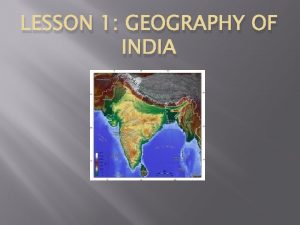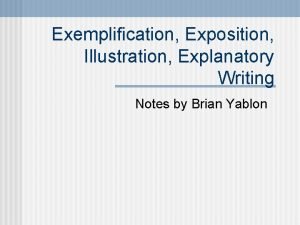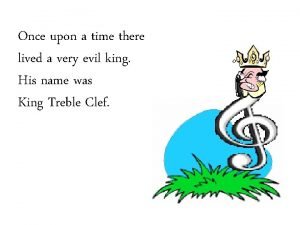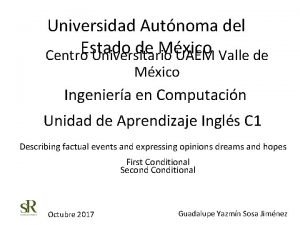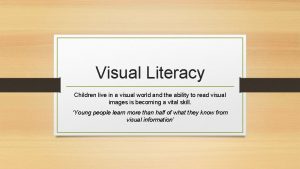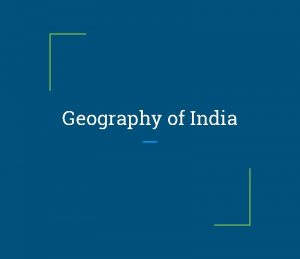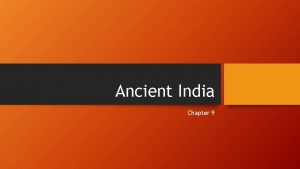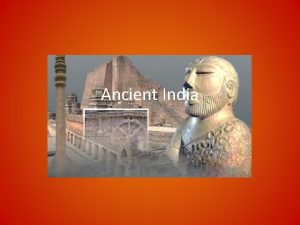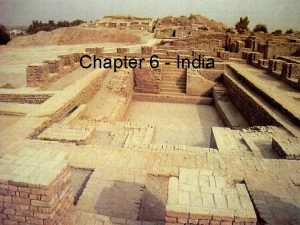India Topic 3 Geography India is a very



















































- Slides: 51

India Topic 3

Geography India is a very large subcontinent Subcontinents are usually separated from the rest of their continents by physical features: mountains, lakes, rivers Much of India is covered with fertile plains, rugged mountains, and plateaus Himalayas: Mountains that separate India from the rest of Asia Mount Everest is the tallest of the Himalayas




Aryans and the Vedic Age India’s first civilization emerged from the Indus River Valley Historians found that Indus River covered largest land area of any ancient civilization Two major cities: Mohenjo-Daro and Harappa Aryan warriors: Europeans and Asians, invaded India


Aryans and Vedic Age Vedas- great Aryan epic poem Examples: Mahabharata and Ramayana Indian epic poems mix history, mythology, adventure, and religion together Writing system: Sanskrit


Hinduism Oldest and most complex religion of the world No single founder, no single text, or hierarchy Has changed over 3, 500 years it has been in existence Religion began when Aryan people added the gods of the Indus civilization to their own Hinduism has countless gods and goddesses

Hinduism Great flexibility and variety of beliefs exist under the general term of “Hindu” No core dogma that people must affirm The belief of Hinduism is up to the individual There about 750 million followers, most live in India

Hinduism Beliefs Universal spirit “God is one, but wise people know it by many names. ” Brahman: Unifying spirit Hindus believe that everything is part of the unchanging, all-powerful spiritual force called Brahman Hindus worship a variety of gods who give concrete form to Brahman

Three Most Important Gods Each of the three can take many forms- animal or human- or represent aspects of Brahman Brahma the Creator: Four heads and arms represent the four Vedas (scripture) Vishnu the Preserver A kind god who protects those who worship him Banishes bad luck, restores good health Comes to earth as an avatar to help humankind in times of crisis Shiva the Destroyer

Reincarnation (Samsara) To Hindus, every person had an essential self- atman Ultimate goal of existence is to achieve mokshaunion with Brahman Individuals must free themselves from selfish desires that separate them from Brahman Most people cannot achieve this union in one lifetime Reincarnation- rebirth of the soul into a new body


Reincarnation (Samsara) Reincarnation allows people to continue working towards moksha through several lifetimes Through reincarnation, people get closer to this union by being born into higher and higher levels of existence Goal: achieve moksha- an end to the cycle of rebirth when one’s atman unites with Brahman- universal soul Belief in reincarnation provided a religious basis for the rigid class systems of the caste system

Karma Karma- all the actions of a person’s life that affect his or her fate in the next life Set of activities of each person and the effects it has on the atman (soul) People who live virtuously earn good karma and are reborn at a higher level of existence, closer to Brahman In Indian art, this cycle of death and rebirth is symbolized by the image of a wheel


Dharma Dharma- religious and moral duties of an individual Hindus stress dharma to escape the wheel of fate Duties vary according to social class, occupation, gender, and age Moral principle: ahimsa- nonviolence

Caste System Socioeconomic groups into which people are born and out of which they cannot move during a lifetime Have a socially rigid society People, through reincarnation, can be born into higher castes if they had good karma in the past Caste system began with the Aryans Aryan people divided society into 4 groups: Varna's Evolved into castes defined by occupation and family lineage Non-Aryans were in the lowest caste


Caste System Brahmins: Priests who performed ceremonies Kshatriyas: Warriors Vaisyas: Herders, farmers, artisans, and merchants Sudras: Farm workers and servants Untouchables: People outside of the caste system because of “polluting” work they do. Work with deal animals and people

Caste System Effects: The general castes are not the same ones today India has thousands of localized castes called jatis Caste relationships are defined locally Government in India presently has worked to eliminate the discrimination of castes Castes determine the conditions of life of most people Personal identity and group loyalty are formed more by local castes than remote governments

Women Men controlled women Women were responsible for running the home in accordance with the man’s wishes Women were not allowed to do anything independently Limited property rights

Sacred Texts Vedas: Collection of prayers and sacred verses Most sacred of Hindu scripture Means “divine knowledge” Originally compiled by the Aryans

Sacred Texts Upanishads Section of the Vedas Philosophical dialogues about Hindu beliefs Centers on the doctrine of Brahman Addresses the mystical questions related to Hinduism

Sacred Texts Brahmanas: Instructions on ritual and sacrifice Mahabharata: Includes the Bhagavad-Gita (“Song of God”) Epic poem of civil war- emphasized the struggles to do one’s duty faithfully

Religious Practices Do not eat beef or pork (cow is sacred) No alcohol Priests also serve as spiritual leaders called gurus No higher or central religious authority Nearly every Hindu home has a shrine with pictures or small statues Diwali Festival of Lights October/November Begins their new year

Geographic Connection Ganges River People went on pilgrimages to wash away their sins Throw ashes of the dead Named after Ganga, “goddess of purification” Himalayas Means “abode of the gods” Source of water for both Ganges and Indus Rivers Mount Everest: “Summit of Heaven” Yeti- abominable snowmen


Buddhism Religion that developed in 6 th century in India and rivaled Hinduism Founder: Siddhartha Gautama, also known as Buddha Siddhartha was a man of wealth, good family Father sheltered him from pain Left palace and encountered pain Quest/mission: remedy for sorrow Meditation: wanted to reach enlightenment

Basic Principles of Buddhism Four Noble Truths Ordinary life is full of suffering Suffering is caused by selfish desires The way to end suffering is to end desire for selfish goals and to see others as extensions of ourselves The way to end desire is to follow the Eightfold Path

Eightfold Path Ultimate goal: nirvana- union with the universe and release from the cycle of death and rebirth Right View: We need t know the Four Noble Truths Right Intention: We need to decide what we really want Right Speech: We must seek to speak the truth and to speak well of others. Right Action: Do not kill, steal, lie, be unchaste, take drugs or alcohol Right Livelihood: We must do work the uplifts our being Right Effort: We must follow the Way Right Mindfulness: We must keep our minds in control of our senses Right Concentration: We must mediate to see the world in a new way Question: How is the Eightfold Path like our Ten Commandments? How are they different?

Sacred Texts After Buddha died, his teaching were collected and written into the Tripitaka or “Three Baskets of Wisdom” Tripitaka- consists of rules for Buddhist monks, sermons, and discussions of Buddhist beliefs

Sections (Sects) of Buddhism Theravada Buddhism Closely follows Buddha’s original teachings Followers were to devote lives to hard spiritual work Only most dedicated could hope to reach nirvana Spread to Sri Lanka and Southeast Asia

Sections (Sects) of Buddhism Mahayana Buddhism Made Buddhism easier for ordinary people to follow Believed Theravada was too strict Showed images of Buddha Followers viewed Buddhism as a religion rather than a philosophy

Decline of Buddhism in India Under Mauryan Empire, especially under Asoka, Buddhism reached its peak Gupta Empire- Indians went back to their Hindu roots

Prior to Mauryan Empire Aryan people occupied India There was no peace in India Kingdoms fought and invaders came through Alexander the Great made an impact


Mauryan Empire (321 -185 BCE) Maurya’s would be the only civilization able to unite India under one rule Mountains helped to protect their civilization from invaders Indus and Ganges Rivers flowed through the north, provided water and fertile soil

Candragupta Maurya Gained power in Ganges Valley and then conquered most of northern India Forged first Indian empire Later, son and grandson added Deccan Plateau to empire Maintained order through bureaucracy Collected taxes Harsh rule- brutal secret police reported on crime, corruption, and dissent Maintained rules on the caste system

Asoka Candragupta’s grandson, Asoka, took over Considered to be the most honored Mauryan emperor Was horrified by brutality Rejected conquests to expand his borders Sent Buddhist missionaries across India Tolerant of other beliefs United the diverse people of empire and brought peace and prosperity Capital: Pataliputra

Asoka Promised a justice government Built hospitals Set up Buddhist shrines Built roads to aid in transportation Came the closest to uniting the entire subcontinent After his death, empire declined and rival kingdoms competed for power

Kushan Empire Came at the end of the Mauryan Empire Included Northern India and Ganges Valley (modern day Pakistan, Afghanistan, and Central Asia) Link for Silk Road- trade route between Mediterranean region and easternmost Asia Traded with Greece- developed Greek alphabet and Persian Zorostranianism Calendar based on sun and moon Persians took over kingdom


Gupta Empire Under Gupta rule, India experienced peace and prosperity Strong government Hindu ideas Had a Golden Age

Chandra Gupta I Local prince- married into an influential family Began to consolidate power Took name Chandra Gupta I- named himself after Mauryan Dynasty

Gupta Society Government Efficient central government Capital is Pataliputra- same as Mauryan Looser form of government than Mauryan Shared power with local leaders and councils Provided stability for economy and culture

Gupta Economy Extensive trade with Southeast Asia, China, and Mediterranean Used the Silk Road for trade Rulers lived in luxury- had gold and silver mines Fertile land Promoted farming and trade

Gupta Women Returned to Hinduism Greater restrictions on women Women could not be on councils Lower class women had to work on the fields

Gupta’s Golden Age- time of great cultural achievement Emphasis on learning, achievements in arts and sciences, booming economy, peace and prosperity Mathematics Concept of zero and decimal system Medicine Used herbs to treat illnesses; set bones; first vaccination for Smallpox Architecture Hindu temple Stupas Pillars
 Figure 10
Figure 10 Quantifiers for food
Quantifiers for food Used to express very large or very small numbers
Used to express very large or very small numbers Few fewfewf
Few fewfewf Receiving table/area
Receiving table/area Very broad topic
Very broad topic Clincher examples
Clincher examples Narrow down topic
Narrow down topic Geography form one topic 2
Geography form one topic 2 Stateless nation
Stateless nation Frq ap human geography format
Frq ap human geography format 5 themes of geography ap human geography
5 themes of geography ap human geography Classical india geography
Classical india geography What are some of the benefits and drawbacks of monsoons
What are some of the benefits and drawbacks of monsoons Shrek extreme long shot
Shrek extreme long shot Oh god the glory is yours
Oh god the glory is yours Strongly flavored vegetables
Strongly flavored vegetables What is question tags and examples
What is question tags and examples My school dream
My school dream Misic psychological test
Misic psychological test It has a very thin atmosphere 
It has a very thin atmosphere  I shall never forget you change into interrogative
I shall never forget you change into interrogative Your smile is important to us
Your smile is important to us Extra wide shot
Extra wide shot You become what you always were a very big fish
You become what you always were a very big fish The cuckoo sings very sweetly
The cuckoo sings very sweetly A heterogeneous mixture of intermediate-sized particles
A heterogeneous mixture of intermediate-sized particles John drives very
John drives very Illustration and exemplification
Illustration and exemplification Pp very soft
Pp very soft Cooking term fold
Cooking term fold Poem features
Poem features Once upon a time there lived a very poor boy
Once upon a time there lived a very poor boy I am
I am Characteristics of ultraviolet rays
Characteristics of ultraviolet rays Our english teacher always
Our english teacher always Give the seven types of feature article
Give the seven types of feature article Pattern development
Pattern development Very brief advice
Very brief advice The mice in a house story writing
The mice in a house story writing The hungry caterpillar song
The hungry caterpillar song What is a vortac
What is a vortac Goldilocks was very tired now en español
Goldilocks was very tired now en español Harmful and useful
Harmful and useful Strong adjectives cold
Strong adjectives cold How was the appearance of hughie erskine
How was the appearance of hughie erskine Vocabulary workshop level d unit 4
Vocabulary workshop level d unit 4 Very long instruction word
Very long instruction word Much ado about nothing summary act 1
Much ado about nothing summary act 1 If his nose were smaller, he _________ very handsome.
If his nose were smaller, he _________ very handsome. Children live in a very visual world
Children live in a very visual world A very thin layer
A very thin layer













